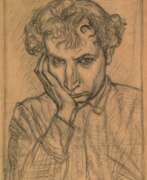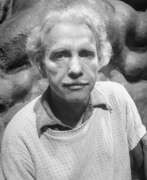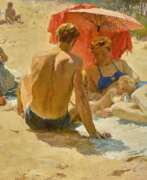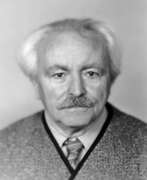Byelorussia Contemporary art


Mikola Bushchik, née Nikolai Vladimirovich Bushchik (Russian: Николай Владимирович Бущик) is a modern Belarusian artist. He is known as a painter and graphic artist working in the expressionist style.
Mikola Bushchik is the author of more than 500 watercolor paintings and about 1000 oil paintings. In the early period of his career he created realistic portraits and landscapes. In the 1990s-2000s, the artist moved away from realism and turned to "color fantasies." Critics often compare the master's paintings to jazz improvisations.


Vitaly Feodosyevich Chernobrisov (Russian: Виталий Феодосьевич Чернобрисов) was a Soviet and Belarusian artist of the last third of the twentieth and early twenty-first centuries. He is known as a painter, sculptor, teacher and public figure.
Vitaly Chernobrisov was an active member of the Leningrad artistic underground of the 1960s and 1970s and is considered a "patriarch" of the Belarusian avant-garde and an adherent of "intuitive" writing.


Nicolai Cikovsky (Russian: Никола́й Цико́вский) — Russian, later American artist of the XX century. Most of the evidence about the artist is associated with his participation in the creative group Hampton Bays, based on Long Island, New York and which included David Burliuk, John Graham, Milton Avery, brothers Raphael and Moses Sawyer.


Isaac Aronovich Davidovich (Russian: Исаак Аронович Давидович) was a Soviet and Belarusian artist of Jewish origin of the second half of the twentieth century. He is known as a painter and graphic artist.
Isaac Davidovich worked in easel and monumental and decorative painting, as well as in easel and book graphics, he drew illustrations and posters. In the field of monumental art he created plafonds and panels.


Robert Lvovich Genin (Russian: Роберт Львович Генин) was a Jewish-born artist of the first half of the twentieth century who worked in several countries, including the Russian Empire, Germany, France, Germany, Switzerland, and the USSR. He is known as a painter and graphic artist.
Robert Genin worked in a variety of genres including landscapes, portraits, genre compositions and nudes. He also did lithography, woodcuts and etching. His style evolved from Jugendstil and Symbolism in the early 1900s to Expressionism after the First World War. He later came to a kind of lyrical primitivism. The artist worked in both easel and monumental painting and was influenced by various artists.


Yakov Andreevich Golubev (Russian: Яков Андреевич Голубев) was a Soviet artist of the mid-twentieth century. He is known as a painter, a representative of the Leningrad art school.
Yakov Golubev began participating in exhibitions while still studying at the painting faculty of the Leningrad Institute of Painting, Sculpture and Architecture. He became famous for his lyrical landscapes. Among his famous works are the paintings "Quiet Day", "Wicket Gate", "Late Autumn" and others.
The master's works are in museums and private collections all over the world, including Russia, Japan, Italy, Germany and France.
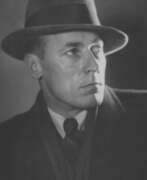

Jazep Mikhailovich Gorid (Russian: Язеп Михайлович Горид) was a Belarusian and Polish-Lithuanian artist of the first half of the twentieth century. He is known as a graphic artist and painter, caricaturist and illustrator.
Jazep Gorid drew political and everyday caricatures, painted portraits and landscapes. He also worked in book graphics, illustrated and designed books and other printed publications. In addition, the artist created stained-glass windows and murals.


Konstantin Ivanovich Khoroshevich (Russian: Константин Иванович Хорошевич) was a Soviet and Belarusian artist of the second half of the twentieth and early twenty-first centuries. He is known as a painter who worked in the genres of landscape, portrait, still life.
Konstantin Khoroshevich during his career created more than 500 paintings, reflecting among other things significant events in the history of Belarus. In the last years of his life he worked on creating a gallery of portraits of cultural figures, his famous compatriots.


Alexander Mikhailovich Kishchenko (Russian: Александр Михайлович Кищенко) was a Soviet and Belarusian artist of the second half of the twentieth century. He is best known as a muralist painter.
Alexander Kishchenko is considered one of the most famous artists of Belarus of the 20th century, and his works are valuable assets of Belarusian culture. He worked in all genres of easel and monumental decorative painting and created hundreds of works during his career, including philosophical paintings and portraits. The artist was also proficient in mosaics, ceramics and tapestry.


Robert Efimovich Landarsky (Russian: Роберт Ефимович Ландарский) is a contemporary Belarusian artist. He is known as a painter working in easel painting in the genre of landscape and figurative painting.
Robert Landarsky is the author of many works with views of picturesque corners of Belarus, as well as paintings on the theme of rural life, which the artist, who grew up in the countryside, knows well. The master of many works devoted to the heroism of people during the war, his brush also belongs to a triptych dedicated to the tragedy of Chernobyl. In the paintings of the artist dominate bright colors, noticeable influence on his work of the Impressionists.


Efim Semyonovich Minin (Russian: Ефим Семёнович Минин) was a Belarusian artist of the first half of the twentieth century. He is known as a painter, graphic artist and teacher.
Efim Minin created portraits, worked in woodblock printing technique, was engaged in exlibris. One of the leading themes of the artist's work was the cityscapes of his native Vitebsk, which he used for many exlibris. His artistic legacy includes several series of woodcuts dedicated, in particular, to Vitebsk and the monuments of the wooden civilization of Belarus.


Alexander Petrovich Mozolev (Russian: Александр Петрович Мозолёв) was a Belarusian Soviet artist of the second third of the twentieth century. He is known as a painter, graphic artist and teacher.
Alexander Mozolev worked in easel painting and graphics - in landscape, portrait, everyday life and battle genres. Many of his thematic paintings were devoted to the Great Patriotic War, in which the artist participated. Among his creative heritage are also many sketches, studies and sketches.


Alexander Ivanovich Rodin (Russian: Александр Иванович Родин) was a Soviet and Belarusian artist of the late twentieth and early twenty-first centuries. He is known as a painter, graphic artist and avant-garde artist.
Alexander Rodin is considered a master of experimental painting and performance art. He is the author of futuristic paintings and landscapes. Surrealistic manner of performance, detailing of subjects, combination of abstract thinking and imagery were characteristic of the artist's work.


Mikhail Andreyevich Savitsky (Russian: Михаил Андреевич Савицкий) was a Belarusian painter, born on February 18, 1922. His experiences in World War II, where he fought and was imprisoned, deeply influenced his artistic work, leading him to focus on themes of war, struggle, and the human spirit. Savitsky's education in art began after his military service; he graduated from Minsk Art College in 1951 and the Moscow Art Institute of Surikov in 1957. He dedicated much of his life to his craft, becoming a significant figure in Belarusian and Soviet art.
Savitsky is renowned for his powerful depictions of war and its impact on Belarus and its people. His works such as “Partisan Madonna” (1967) and “Leaving in the Night” (1980) are celebrated for their emotional depth and artistic mastery. “Partisan Madonna,” for instance, is viewed as a symbol of Belarusian defense during World War II, portraying a peasant mother as a figure of resilience and protection. On the other hand, “Leaving in the Night” explores the themes of sacrifice and maternal strength during times of conflict, representing the broader struggles faced by Belarus during the war.
Throughout his career, Savitsky received numerous accolades, including the title of People's Artist of the USSR in 1978 and the Hero of Belarus award in 2006. His works are a testament to the resilience of the human spirit in the face of adversity and are housed in various museums and galleries, notably the Minsk State Art Museum and the Gallery of Savitsky in Minsk.
For collectors and experts in art and antiques, Savitsky's oeuvre offers a profound insight into the Soviet and Belarusian artistic narrative, underlined by historical events and personal resilience. His legacy continues to inspire and resonate, providing a window into the experiences that shaped a significant era in Belarusian history.
To stay updated on works and auction events related to Mikhail Andreyevich Savitsky, sign up for updates. This subscription will keep you informed about new product sales and auction events, ensuring you don't miss out on important opportunities related to Savitsky's profound and impactful art.


Mikhas Sevruk (Russian: Михаил Константинович Севрук) was a Belarusian and Lithuanian artist of the mid-20th century. He is known as a painter, graphic artist, illustrator and engraver.
Mikhas Sevruk is considered a representative of the Vilna art school, which is characterized by the traditions of academic and neo-realistic art. At the beginning of his career, the artist leaned towards romanticism. In the last three decades the artist created mainly genre paintings and landscapes.


Saveliy Abramovich Sorin (Russian: Савелий Абрамович Сорин) was a Russian painter renowned for his exceptional portrait works. Born in 1878 in Polotsk, Vitebsk province, into a modest Jewish family, Sorin's journey in art took him from Russia to the West, notably France and the USA, where he established himself as a distinguished portraitist by the early 20th century. His education at the Academy of Fine Arts, under the guidance of illustrious teachers including Ilya Repin, laid a strong foundation for his career. Sorin's talent for capturing the essence of his subjects through graceful and precise imagery won him acclaim and a diverse clientele, ranging from aristocrats and royals to fellow artists and cultural figures.
Throughout his career, Sorin lived and worked across various locales, including St. Petersburg, the Crimea, Tiflis, France, and the United States, reflecting a life marked by both artistic and geographic exploration. His notable works include portraits of prominent Russian cultural figures such as Maxim Gorky, Fyodor Chaliapin, Anna Akhmatova, and Tamara Karsavina, showcasing his ability to capture the spirit of Russian culture through his art. Sorin's works are a testament to his skill in combining the richness of color with precise drawing, achieving a remarkable likeness in his portraits.
Saveliy Abramovich Sorin's legacy is preserved in his contributions to art, with many of his pieces donated to museums in the USSR, alongside those held in private collections and museums worldwide. His life and work exemplify the journey of a talented artist navigating the challenges of his time, leaving behind a rich portfolio that continues to captivate and inspire.
For collectors and art experts intrigued by Sorin's legacy and the unique charm of his portraits, staying updated on related sales and auction events is essential. Signing up for updates on Saveliy Abramovich Sorin ensures you remain informed about new opportunities to explore and acquire works by this remarkable artist, enriching your collection with pieces that embody the elegance and depth of early 20th-century Russian portrait art.


Mikhail Petrovich Staniouta (Russian: Михаил Петрович Станюта) was a Belarusian Soviet artist. He is known as a painter, graphic artist and teacher.
Mikhail Staniouta worked mainly in easel painting in the genres of thematic painting, portrait, landscape, still life. His narrative and thematic paintings were distinguished by their topicality, expressiveness of composition and drawing, color saturation. The artist also worked in graphics, which in his creative heritage is represented, in particular, by sketches of self-portraits of the master.


Nikolai Ivanovich Volynets (Russian: Николай Иванович Волынец) was a Soviet and Belarusian artist of the second half of the twentieth and early twenty-first centuries. He is known as a painter who worked mainly in the genres of landscape and portrait, a follower of the Vitebsk school of painting.
Nikolai Volynets wrote landscapes from nature by the technique of large brushstroke. Models for his portraits became, as a rule, heroes of war and labor, political and creative figures and ordinary citizens, contemporaries of the artist. Some portraits he created using leaves of trees and feathers of birds. At the end of his life, the artist turned to religious themes, and participated in the painting of walls in temples.


Rostislav Ivanovich Vovkushevsky (Russian: Ростислав Иванович Вовкушевский) was a Soviet and Russian artist of the second half of the twentieth century. He is known as a painter, muralist and teacher, a representative of the Leningrad school.
Rostislav Vovkushevsky actively exhibited his works since 1949. He worked in both easel and monumental painting, his work included still lifes, portraits, landscapes and genre compositions. Important works of the artist were monumental panels, mosaic compositions and ceremonial curtains for auditoriums. His style was distinguished by decorative elements, clear silhouettes and rich color, as well as rhythmic organization of the canvas.
His works are in museums and private collections around the world.
